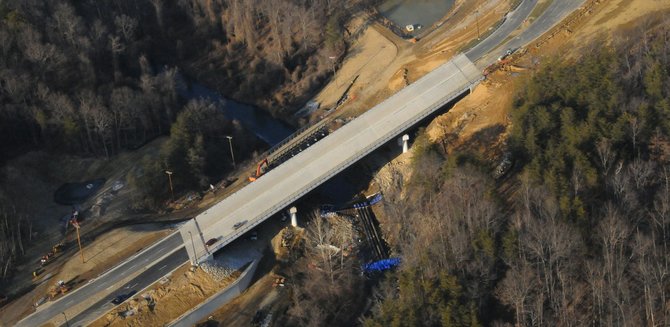A view of the North Loop Road Bridge as it crosses over the construction of a Coffer Dam at Accotink Creek at the National Geospatial-Intelligence Agency Campus East project.
Across Mount Vernon, large-scale 1960s-era parking lots dominate the landscape and flood the streams. Now the U.S. Environmental Protection Agency is taking aim at that rush of water, calculating pollution based on the flow of water that is released into the Chesapeake Bay. That’s a drastic change from the previous calculation, which was based on the amount of sediment dumped into the streams and tributaries that flow into the bay. And it’s leading to an increasingly pitched conflict between Fairfax County and the EPA.
“Part of the dispute between the county and EPA is whether EPA even has the authority to declare the amount of water as the actual pollutant,” said Del. David Bulova (D-38). “It’s not clear to the county whether or not the EPA really has the authority to simply declare that too much water is also now a pollutant that would be regulated under the federal Clean Water Act.”
Last month, federal officials informed Virginia that the commonwealth will lose $1.2 million in federal grants because of the lack of progress in reducing stormwater runoff from city streets, parking lots and urban storm drains. Federal officials say Virginia can reapply for funding if it makes improvements, but the debate in Fairfax County is likely to linger. Over the summer, Fairfax County and the Commonwealth of Virginia filed a lawsuit challenging the EPA’s new stormwater regulations for the Accotink watershed. Some say that course of action is a mistake.
“Attacking the regulatory action as illegal or inappropriate, to me, is kind of overkill,” said Del. Scott Surovell (D-44). “I think the county ought to enter into negotiations instead of trying to tell the EPA that they are wrong.”
THE DISPUTE isn’t just about science. Many Democrats in Northern Virginia are uncomfortable with the politics of Fairfax County entering into a lawsuit with Republican Attorney General Ken Cuccinelli on an environmental issue. Cuccinelli, who used to represent Fairfax County in the Senate, is now a candidate for governor. Del. Kaye Kory (D-38) says joining with the controversial attorney general could damage the county’s standing.
“Under [former Fairfax County Board of Supervisors Chairman] Gerry Connolly, we were all so proud of the environmental steps we had taken and really saw Fairfax as a leader in the green counties,” said Kory. “So I think simply the headline that the county is suing the EPA and they are partnering with Cuccinelli is very damaging to that reputation.”
Fairfax County Board of Supervisors member Gerry Hyland (D-Mount Vernon) disagrees. He says that the county is pursuing an important challenge.
“We should be joining with the Commonwealth of Virginia in challenging the EPA’s authority on a rule that could bankrupt local jurisdictions,” said Hyland. “Where are we going to get the hundreds of millions of dollars in Fairfax County to do what we feel is a requirement they don’t have the right to impose? Raise taxes?”
THE ISSUE is especially acute here in Mount Vernon, which is full of infrastructure designed for a different era. Most of the stormwater runoff that exists along the Route 1 corridor is designed to get the water off the streets and into the creeks. So far, the county has not taken steps necessary to modernize how stormwater runoff flows though Mount Vernon.
“Basically any time you get any kind of moderate rainfall, the creeks in my district turn into a toilet bowl,” said Surovell. “There’s probably a significant part of the 44th District that’s currently sitting at the bottom of the Potomac River and the Chesapeake Bay because the county and the state have refused to take action for 40 years.”
Hyland says the county has been hard at work to solve the problem, but the EPA is asking for too much too quickly.
“Every watershed in Fairfax County is now waiting for the money to do the capital projects to make the changes needed to hold the stormwater,” said Hyland. “But this rule requires this now, and it just will not happen.”
